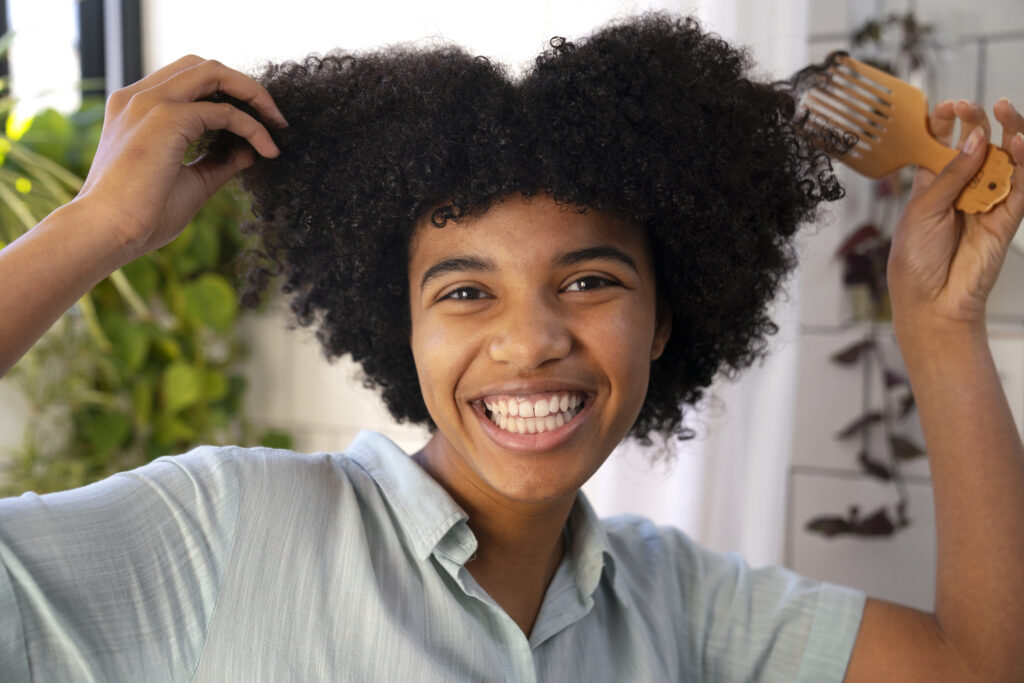Hair Loss
Hair loss is a deeply personal experience that affects millions of people around the world, regardless of ethnicity or hair type. However, when it comes to Afro-textured hair, the process of hair transplantation presents a unique set of challenges and technical intricacies. The distinctive curl pattern, density, and follicular structure of Afro-textured hair require advanced expertise and specialized techniques to achieve natural-looking, long-lasting results.
In this article, we’ll explore the science behind Afro-textured hair transplants, the methods used, and the key challenges that make this procedure both complex and rewarding when performed by experienced professionals.
Afro-Textured Hair
Afro-textured hair is characterized by its tight curls, high density, and unique follicular structure. Unlike straight or wavy hair types, Afro hair grows in a curved shape beneath the skin’s surface. The follicles are more curved or “C-shaped,” which influences both the direction of hair growth and the extraction process during a transplant.
This distinctive structure gives Afro hair its volume and texture, but it also increases the risk of follicle transection (damage to the root) during extraction if the surgeon is not experienced in handling such hair types. Therefore, successful Afro hair transplantation depends heavily on precision, experience, and the use of the right tools and techniques.
Common Causes of Hair Loss in Afro Hair
Hair loss in individuals with Afro-textured hair can be triggered by various factors, including:
- Traction Alopecia: Common among those who frequently wear tight hairstyles such as braids, cornrows, or weaves, which can pull on the roots and cause permanent hair loss over time.
- Central Centrifugal Cicatricial Alopecia (CCCA): A form of scarring alopecia primarily affecting women of African descent, leading to patchy baldness starting from the crown area.
- Genetic Factors: Androgenetic alopecia, or hereditary hair loss, can affect both men and women of African ancestry.
- Chemical Damage: Frequent use of relaxers, dyes, and heat styling can weaken the hair shaft and contribute to thinning.
Understanding the underlying cause of hair loss is crucial for determining the right treatment approach—whether that’s a transplant or a combination of medical therapies.
Techniques Used in Afro-Textured Hair Transplants
When it comes to Afro-textured hair, two primary techniques are typically used: FUE (Follicular Unit Extraction) and FUT (Follicular Unit Transplantation). Each has its own benefits and considerations depending on the patient’s needs.
1. Follicular Unit Extraction (FUE)
FUE is one of the most popular methods for Afro hair transplants today. In this minimally invasive procedure, individual follicular units are extracted directly from the donor area (usually the back of the scalp) using micro-punch tools.
Why it’s ideal for Afro hair:
- Leaves minimal scarring, which is beneficial for darker skin tones prone to keloid formation.
- Allows the surgeon to selectively extract healthy follicles.
- Faster healing and less downtime compared to FUT.
However, due to the curly nature of Afro hair follicles beneath the skin, the surgeon must use specialized curved punches or advanced extraction tools to minimize follicle transection.
2. Follicular Unit Transplantation (FUT)
In the FUT method, a strip of scalp is removed from the donor area and then dissected under a microscope to extract follicular units.
Benefits for Afro-textured hair:
- Provides a higher yield of viable grafts.
- Suitable for patients who require extensive coverage.
The drawback, however, is that FUT leaves a linear scar, which may be more visible in those who prefer shorter hairstyles. That’s why many modern clinics now favor Bio-FUE techniques for Afro hair restoration.
Challenges in Afro Hair Transplants
Performing a successful Afro-textured hair transplant requires advanced surgical skill and deep anatomical understanding. Here are some of the key challenges involved:
1. Curved Follicles
Afro hair follicles are tightly coiled beneath the skin. This means that the extraction process requires extreme precision. A straight punch tool can easily cut through the follicle, reducing graft survival rates. Skilled surgeons use curved extraction tools and adjust their hand angles during the procedure to follow the natural curve of each follicle.
2. Limited Donor Supply
Because of the density and curl pattern, fewer follicles may be available in the donor area compared to straight hair types. The surgeon must carefully calculate graft numbers to ensure adequate coverage without depleting the donor region.
3. Scalp Sensitivity
Patients with Afro-textured hair may have more sensitive skin or be prone to certain types of scarring, such as keloids. Choosing the right technique (typically FUE) and ensuring proper post-operative care can reduce these risks.
4. Curl Pattern Matching
One of the most important aspects of an Afro hair transplant is replicating the natural curl pattern and density. This requires precise angling of graft placement and an artistic eye to ensure a natural, symmetrical look.
Recovery and Results
Recovery from an Afro-textured hair transplant typically takes around 7–10 days for initial healing, though full results can take up to 12 months to become visible. During this period, patients are advised to:
- Avoid tight hairstyles or chemical treatments.
- Follow a prescribed hair care routine from the clinic.
- Attend follow-up sessions for scalp assessments and PRP therapy if recommended.
When performed correctly, Afro hair transplants deliver beautiful, natural results with restored density and curl pattern.
Why Experience Matters
Afro-textured hair transplants are among the most technically demanding procedures in the field of hair restoration. Not every clinic or surgeon has the experience or specialized equipment required to handle the unique challenges involved. Patients must carefully choose a clinic that not only understands the anatomy of Afro hair but also uses advanced technology such as Bio-FUE and PRP-assisted grafting for enhanced growth and survival.
Final Thoughts
Afro-textured hair transplants combine science, precision, and artistry. With the right surgeon and technology, patients can achieve full, natural results that restore both appearance and confidence.
At Hair Clinic Dubai™, we specialize in Afro-textured hair transplants using advanced Bio-Enhanced FUE techniques. Our team of DHA-licensed surgeons understands the unique structure and needs of Afro hair, ensuring a smooth, comfortable, and highly successful experience.
If you’re searching for the best hair transplant clinic in Dubai that offers affordable Afro-textured hair restoration, Hair Clinic Dubai™ is your trusted destination for natural results and renewed confidence.


